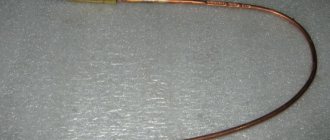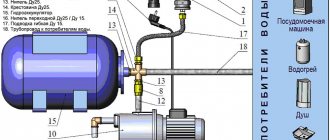To work with wooden, plastic and even metal workpieces at home, a circular hand saw is often used as a more productive analogue of the simplest sawing tool. It has several varieties and application nuances that are important to consider when working.
Circular hand saw device
When constructing and repairing both your own home and on a professional basis, a circular hand saw becomes a convenient aid in your work. The tool is very convenient for sawing wood of different thicknesses, thin metal and plastic products, such as baseboards. There are several varieties of this manual circular saw, but the design of each of them is typical. The standard design consists of:
- Protective plastic housing with one or two handles.
- A special casing for the saw blade that performs protective functions during operation.
- Platforms for holding and guiding the disc. It is necessary to adjust the depth and angle of the cut.
- Riving knife. It is needed to free the knife if it gets stuck in the wood.
- Electric motor. A special disk is attached to its shaft using bolts.
Types of circular saws
A stationary circular saw is installed on a stationary workbench or table. It has high productivity due to its powerful engine and large saw blade. In addition, the presence of a stationary working surface allows for convenient and accurate cutting of long pieces of wood.
Circular machine
A hand-held circular saw is usually used in everyday life. Its main advantages are small dimensions, weight and mobility. It allows you to cut small wooden boards and bars, as well as wood products. You don't need a workbench to use it. Almost all models are equipped with an adjustable sole, which makes their use more comfortable.
Hand circular saw
Compact size and weight allow the table saw to combine the positive qualities of the types described above. They are distinguished by mobility and the ability to finely adjust the cutting angle. The disadvantage of such a tool is the small radius of the saw blade and the low power of the electric motor.
Table saw - machine
The plunge-cut circular saw is a modernized hand-held circular saw. Design features allow for more precise cuts at different angles relative to the horizontal plane, as well as for making local cuts. The main disadvantage of the tool is its high cost.
Plunge circular saw
Application area
A circular saw is mainly used for working with wood products. With its help you can perform the following types of work:
- Longitudinal and transverse cutting of workpieces;
- performing local cuts;
- trimming ends;
- firewood preparation;
- production of boards, bars and other wood products.
In addition, when installing a specialized cutting element, they can be used to cut plastic, artificial stone and tiles.
We also recommend reading a useful article about techniques for even cutting with a circular saw with and without attachments. The article discusses the most necessary techniques and techniques for cutting various materials, from unedged boards to timber and logs.
Working principle of a circular hand saw
The tool is used for even sawing of surfaces, longitudinally or transversely. Arc cutting is not possible with a circular hand saw. The principle of operation of such a unit is simple:
- Torque is transmitted from the electric motor shaft to the cutting disc.
- The sawing disk rotates around its axis at high speed, making it easy to cut the desired surface.
Depending on the cutting depth, the tool is divided into several categories:
- Mini circular hand saws are capable of cutting material up to 46 mm thick.
- The average tool can handle surfaces up to 55 mm.
- Large equipment can cut workpieces with a thickness of about 70 mm.
- Professional equipment cuts products about 140 mm thick.
Design and principle of operation of individual components
To better understand the operating principle of the tool, it is necessary to understand the structure of its main components.
Electric motor
Modern circular saws use a commutator-type electric motor. It has small dimensions, weight, high efficiency and can operate on both direct and alternating current.
The insides of the electric motor, namely its stator part.
Its operation is based on the principle of electromagnetic induction that occurs in the stator winding. When you press the power button, electric current is supplied to the winding, and the resulting force field sets the motor armature in motion.
Saw blade
The saw blade is the main working unit of the circular saw. Designed for cutting wood and products made from it. Structurally, it is a metal disk with a toothed rim, with the help of which wood is cut. The number of teeth ranges from 12 to 100 pieces. Depending on the material of manufacture, they are divided into the following groups:
- Monolithic. Tool steel is used as the material for their manufacture. They have high strength, reliability and maintainability;
- Carbide. The main part of the disc is made of tool steel, and the cutting crown is made of various alloys based on tungsten carbide. Their distinctive features are high tooth strength and long service life, which is why they are used for processing hard wood.
Cutting angle adjustment system
The cutting angle adjustment system includes a support sole, an adjustment device with a lock and a measuring scale.
The support sole is located at the bottom of the tool. Made from aluminum or structural steel. Serves for convenient movement of the tool along the surface being processed. There are devices for adjusting the cutting angle vertically and horizontally.
For ease of use, the saws are equipped with a measuring scale, which allows you to more accurately adjust the working angle.
Safety system
The safety system of a hand-held circular saw is represented by a protective casing, which is located around the saw blade. It is designed to prevent the operator's hands from coming into contact with the saw blade and to prevent injury from damage to the saw blade. High-strength structural steel is used as the material for the manufacture of the casing.
The casing design consists of two segments. The upper one is rigidly fixed to the saw frame, the lower one is movable. When it comes into contact with the surface being processed, it fits into the gap between the disk and the upper part and does not interfere with work. After completion of work, it automatically returns to its original position thanks to a coil spring.
How does the circular saw emergency stop work?
No way, because There is no emergency stop for a hand-held circular saw. That is why during operation the operator must stand to the side of it and hold it firmly with both hands, and there should be no one around. When the disk jams, the tool can fly out of the operator’s hands and fly several meters upward or to the side. In the best case, the casing will have time to work and close the saw blade.
Some manual models use an intermediate shaft between the disk shaft and the electric motor, which shears during jamming, but this is more aimed at preserving the electric motor than at operator safety.
Stationary power saws have an electromagnetic brake that stops the blade from rotating. This also allows you to simply stop the disk spinning faster.
Types of Circular Hand Saw
There is a large selection of circular saws on the shelves of construction stores. All variety can be divided into:
- A hand tool that the master moves independently.
- A stationary saw on a special table, designed for placement in work shops and workshops.
The circular hand saw is divided according to power classes into:
- Household appliances with power up to 2.2 kW.
- Semi-professional models that are more powerful than household ones. They have great functionality.
- Professional units with increased power and functionality. Used in production.
Another difference is the method of transmitting torque, so they distinguish:
- Electric models connected to a standard power supply.
- A cordless hand-held circular saw is convenient where you don't need a nearby power outlet.
- Models with manual drive, which are currently practically not used, are becoming a thing of the past.
How to choose a circular hand saw?
When purchasing a tool, you should focus on a number of specific parameters:
- Engine power. The higher it is, the faster and with less effort you can cut. In addition, large-diameter cutting discs can be installed on powerful saws (from 3 kW).
- Cutting depth. There are 4 standard sizes that you need to select based on your needs.
- A hand-held circular saw for wood can have an adjustable cutting angle.
- Stationary chip removal system or the ability to connect a vacuum cleaner. A very convenient option that allows you to work practically without dust and debris in the workshop or at home.
- The start lock is an important safety feature that prevents the tool from being started accidentally.
Functions of a circular hand saw
The main “duty” of a circular saw is to cut large quantities of boards, drywall, laminate, plastic panels, soft metal and more. It is indispensable when building a house or cottage, and is also useful when laying floors in an apartment or covering walls with decorative panels. For speed of work and ease of use, the circular electric hand saw is equipped with a number of additional functions:
- Immersion in the material. This function is very convenient when working with large slabs.
- Adjusting the speed of rotation of the cutting disc. To work with different materials, different rotation speeds are required to obtain an even cut without burrs.
- The soft start function is necessary to increase the service life of the cutting blade. Thanks to it, the saw smoothly picks up speed after starting, rather than immediately spinning the shaft to maximum speed.
- A laser pointer is an optional accessory for a handheld circular saw. However, such a pointer is convenient to use when carrying out quick work.
Circular saw blades
An important consumable in a cutting tool is the cutting disc. Each model has its own characteristics:
- height and number of teeth;
- cutting profile geometry.
Conventionally, all disks for hand-held circular saws are divided into:
- Consumables for soft materials such as wood or plastic. They have a positive sharpening angle, the number of teeth is about 50-100, which ensures an even cut.
- Discs for hard materials are produced with a negative sharpening angle and fewer teeth. They can cut through harder materials, but the edges will be more jagged.
Miter saw
What is a miter saw? A crosscutter is a tool for precise, mainly transverse, cutting of a workpiece. Most miter saws are small and portable. Unlike stationary cross-cut saws, you can pull it out and set it on a temporary base by placing the drop mechanism (sometimes called a drip) over your workpiece. The blade sizes most commonly used for miter saws range from 8 to 12 inches (20-30 cm).
What is a miter saw used for? You can use it to create cross cuts on a workpiece in one quick motion. But more importantly, you can do it at the angle you choose. This is the best choice if you need to cut trim and moldings.
Pros A miter saw is useful when you require precise cross cuts on your workpieces. This saw is also a great option for miter cuts. This is one of the main competitive advantages of this saw over other types of saws. What’s important is that the miter saw is one of the safest.
Cons Despite all the advantages, a miter saw is not useful when you are going to cut large pieces. While it is the best choice for cross sections, miter cutting may not be effective for long cuts (over 15 centimeters). Miter saws are more of a luxury than a necessity.
Rating of circular hand saws
Professional builders and home craftsmen identify certain tool models that have the most optimal characteristics for the job. Among them:
- Makita HS7601
is an excellent device for home use with two branded disks included. Cost – $121. - DeWALT DWE560
is a model with the ability to connect a construction vacuum cleaner. Cost – $140. - Hammer CRP 1500 D
is a high-quality lightweight saw with a convenient carrying case. Cost – $93. - Bosch GKS 190
. The Bosch hand-held circular saw is considered one of the best tools in its price segment. Cost – $128.
Hand circular saw table
When working with a large volume of sawn material, it is not always comfortable to hold the tool in your hands for a long time. It is much more convenient to secure the tool on a special table, so the cut will be more accurate and faster. All masters prefer to use:
- Factory tables purchased from a store. They can be either stationary or portable.
- Homemade tables, the advantage of which are individual sizes suitable for the workshop area and additional options.
After making your own table, it is important to know how to properly secure your handheld circular saw to your table. There are just a few rules here:
- The instrument is placed inside a prepared compartment that is exactly the right size for the instrument.
- The saw base is securely attached to the table with bolts.
- The disk should fit freely into the slot.
What is it and what can she do?
A circular saw is a specialized tool primarily intended for cutting wood and wood products. Structurally, it can be divided into the following types:
- Stationary;
- Manual;
- Tabletop;
- Submersible.
In all cases, a metal disk with teeth located around the circumference is used as a cutting element.
With a circular saw you can make cuts in wood up to 60-70 mm deep; some craftsmen even manage to evenly cut a 100x100 beam or a 150x150 log with a circular saw using special devices.
The tool can also cut plywood, chipboard, chipboard, MDF and even soft metals. The main thing is to select the right disk for each task, use the correct cutting techniques and devices.
How to use a circular hand saw?
There are standard instructions on how to use a hand-held circular saw, which for different models will differ only in nuances:
- Before starting work, it is important to ensure that the tool is in working order.
- Secure the cutting blade, adjust the position of the guide pin, check the protective cover and the parallelism of the stop with the groove and the pin.
- Set the minimum required cutting depth.
- Set the guide to the size of the material and mark it.
- Make a test cut 3-5 mm long.
- Continue working without stopping along the entire movement of the disk.
- You can use adhesive tape at the cut site to prevent chipping.











